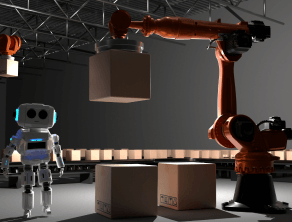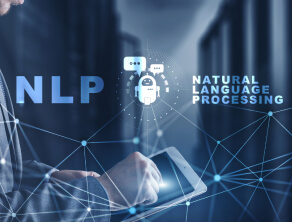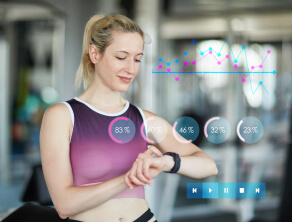Top AI Trends to be Leveraged by Manufacturing, Agriculture and Healthcare Industries in 2020
Table of Contents
From a futuristic piece of tech associated with sci-fi, AI has now become a part of our daily lives through various applications and gadgets around us, like google maps which uses Machine Learning algorithms to offer users a better experience, or Siri and Alexa and several chatbots are marvelous creations of AI. Even the keyboard you use on your phones uses AI to offer predictive suggestions.
On a much larger and complex scale, AI is having a transformative impact almost across every booming industry. The global AI software market is projected to hit 126 Billion USD by 2025 as per a recent report by Statista.
From predictive maintenance in manufacturing units to helping researchers cure cancer; and farmers produce larger yields using fewer resources, AI is helping humans achieve groundbreaking results in a much shorter span of time which was all previously impossible.
AI has also proved to be a valuable resource in the fight against COVID-19. Drug development companies are using AI to simulate several variations of drugs and governments are using AI to predict the spread of coronavirus and to monitor people and establish safety measures.
In this post, we’ll explore the impact AI has on the Healthcare, Manufacturing and Agriculture industries and what benefits it has to offer.
HEALTHCARE
The global Artificial Intelligence (AI) in the healthcare market scope was projected at $2.5 billion in 2018. It is likely to reach $31.3 billion by 2025 with a CAGR of 41.5 percent during the prediction period.
This is a result of the increasing dependence on AI in healthcare. It is an industry where big data holds great significance and AI can help in analysing this data and recognizing patterns that are usually overlooked by humans, that too much faster and accurately. With the power of AI, healthcare professionals are achieving results in a matter of days and hours that would usually take months. Out of the many ways AI has revolutionized the healthcare industry, here are a few recent and significant ones.
-
Mining and managing medical data
Healthcare industry relies on huge repositories of data. Highly valuable information can sometimes get lost among the forest of trillions of data points, losing the industry around $100 billion a year. The ability to identify patterns and connect data points can be extremely difficult and time consuming. With AI we can achieve this in a significantly lesser time and much more efficiently and accurately. AI breaks down data silos and connects in minutes, the information that used to take years to process.
Big data and artificial intelligence can predict clinical, financial and operational risk by taking data from existing sources to foretell everything from who might get sick to what’s driving up a hospital’s healthcare costs- to predict ICU transfers, improve clinical workflows and even pinpoint a patient’s risk of hospital-acquired infections.
At [x]cube labs, we developed an algorithm for one of the top pathology labs in India which helped them predict the time of report delivery for the convenience of their customers. Our expert team, having extensive experience on a range of machine learning tasks, accessed their historic and master data, cleaned, and analyzed it. Our team used a comprehensive approach where algorithms were not only customized but applied multiple times to gain the accuracy that we had hoped for. Read more about it here.
-
Developing new medicines
Development of new drugs is a cumbersome process. It involves numerous phases that consume a lot of time and capital. It costs about $2.6 billion to put each drug through clinical trials, and only 10% of those drugs are successfully brought to market. With AI, biopharmaceutical companies can achieve greater levels of efficiency, accuracy and knowledge.
MIT’s researchers claim their AI is able to check more than 100 million chemical compounds in a matter of days to pick out potential antibiotics that kill bacteria. This rapid checking reduces the time it takes to discover new lifesaving treatments and begins to swing the odds back in our favour. The algorithm was trained using around 2,500 molecules – including about 1,700 FDA-approved drugs and a set of 800 natural products – to seek out chemical features that make molecules effective at killing bacteria.
-
Diagnostic chatbots
AI-powered chatbots are finding increased usage in healthcare systems where they are used to collect data and provide basic diagnosis to patients, especially on virtual healthcare platforms. Using chatbots in such cases ensures an immediate response and saves human executives a lot of time which enables them to take up tasks that require higher cognitive abilities.
Chatbots can be used to streamline the review of a patient’s symptoms and collect other relevant data, then recommend either a virtual check-in or a face-to-face visit with a healthcare professional.
-
Shorten hospital wait times
Making the decision on when to discharge patients who are really sick and unstable can be very difficult. Overcrowded hospitals and longer wait times are perennial problems and during surge times such as nowadays, it becomes really crucial for doctors and nurses to make the right call.
AI can help doctors and nurses be confident as to which patients are ready to leave hospital and which should stay. AI can be used to constantly monitor the patients’ vitals and provide data that can assist doctors and nurses in making more informed decisions, thus accelerating the process.
-
Efficient and accurate diagnosis
In 2015, misdiagnosing illness and medical error accounted for 10% of all US deaths. In light of that, the promise of improving the diagnostic process is one of AI’s most exciting healthcare applications.
Incomplete medical histories and large case loads can lead to deadly human errors. Immune to those variables, AI can predict and diagnose disease at a faster rate than most medical professionals. In one study, for example, an AI model using algorithms and deep learning diagnosed breast cancer at a higher rate than 11 pathologists.
A new AI system developed by researchers from Google and the University of California could prevent deaths caused by incorrect prescriptions. The AI is able to predict which conditions a patient is being treated for based on certain parameters. It was trained on an anonymised data set featuring around three million records of medications issued from over 100,000 hospitalisations.
BOOK A CONSULTATION FOR FREE!
Talk to our digital experts on how you can leverage digital to scale your initiatives!
-
AI vs Coronavirus: Some AI assistance
AI tools and services are being used or offered by companies around the world to help fight the coronavirus pandemic.
China’s Tianhe-1 supercomputer is offering doctors around the world free access to an AI diagnosis tool for identifying coronavirus patients based on a chest scan. The supercomputer can sift through hundreds of images generated by computed tomography (CT) and offer diagnosis in about 10 seconds.
AI powered computational platforms are being used by researchers and institutions working towards a vaccine to accelerate data transfer and computation time in areas such as virtual drug screening.
AI solutions are being used to estimate the trajectory of a coronavirus outbreak in a specific region using a machine learning algorithm based on public data gathered from 31 provinces in China. Within China, it has a 98 percent accuracy rate.
AI systems are being used to examine large repositories of medical information to identify compounds that effectively block a cellular pathway that appears to allow the virus into cells to make more virus particles. This can help researchers identify approved drugs that might block the viral replication of COVID-19.
While the outlook around the world is currently grim, some of these AI-powered tools and developments offer a glimmer of hope that we may be able to reduce the virus’s spread, improve treatment for patients, and ultimately conquer the coronavirus sooner than otherwise would have been possible.
MANUFACTURING
AI in the manufacturing market is expected to grow at a CAGR of 39.7% from 2019 to 2027 to reach $27 billion by 2020 according to a recent report by Meticulous Market Research. The manufacturing industry has always been open to adopting new technologies. Drones and industrial robots have been a part of the manufacturing industry since the 1960s. With the adoption of AI if companies can keep inventories lean and reduce the cost, there is a high likelihood that the American manufacturing industry will experience an encouraging growth. Having said that, the manufacturing sector has to gear up for networked factories where supply chains, design teams, production lines, and quality control are highly integrated into an intelligent engine that provides actionable insights.
Manufacturing businesses in the US using AI are performing 11.5 percent better than those that aren’t according to a research by Microsoft. AI benefits the industry. Why? Its possible applications are extensivend the stats are enticing. According to McKinsey, 50 percent of companies that invest in AI over the next five to seven years will have the potential to double their cash flow; manufacturing is leading the way due to its heavy reliance on data.
Here’s how the manufacturing industry is leveraging AI today:
-
Predictive Maintenance
Maintenance is a key area that can drive major cost savings and production value around the world. The cost of machine downtime is high: according to the International Society of Automation, $647 billion is lost globally each year.
With AI and machine learning, we have the ability to process massive amounts of sensor data faster than ever before. This gives companies an unprecedented chance to improve upon existing maintenance operations.
Predictive maintenance uses data from various sources like historical maintenance records, sensor data from machines, and weather data to determine when a machine will need to be serviced. Leveraging real-time asset data plus historical data, operators can make more informed decisions about when a machine will need a repair. Predictive maintenance takes massive amounts of data and through the use of AI and predictive maintenance software, translates that data into meaningful insights and data points.
-
Next-generation software design
It’s a new way of looking at things. Designers or engineers enter their ultimate design goal into generative design software, complete with cost constraints, preferred materials and methods. The software then takes the original idea and explores different solutions to make it a reality on the spot. The result: you get many design possibilities, a conclusion of whether they’ll work or not, and a recommendation for the best solution. It could be used from everything from aircraft wing design to plastic molds for a phone case.
Brian Matthews, Vice President of Platform Engineering at Autodesk, US, says it could achieve 50,000 days of engineering in one day.
-
Industrial automation
For the manufacturing industries to stay competitive with other domains there is a serious need for them to come out of their legacy systems by automating their traditional processes. Every manufacturer needs to have the potential of implementing machine learning applications in order to achieve predictive accuracy in production.
The growing changes in consumer behavior in regards to customization and product quality, it is difficult for the manufacturers to make changes in the production system (like re-programming or re-tooling the application) in a short time. This is where machine learning benefits the manufacturers. The machine learning application examines and performs maintenance on production apparatus, optimizes the production & supply chain efficiency by reprogramming the unit computers and assists in delivering products on-time.
-
Reduced operational costs
Many companies are viewing the introduction of AI into the manufacturing industry with trepidation, as it requires a huge capital investment. On the other hand, the ROI is significant and increases as time goes on. Once intelligent machines begin to take over the daily activities of a factory floor, businesses will benefit through considerably reduced operating costs, with predictive maintenance helping additionally to reduce machine downtime.
These days, consumers are increasing their demand for unique, personalised or customised products, while continuing to expect the best value. Integrating machine learning and CAD means that systems can be designed and tested in a virtual model before they are put into production, thus reducing the cost of trial-and-error machine testing.
-
Novel opportunities for humans
As AI takes over the manufacturing plant and automates simple and ordinary human tasks, workers will get to focus on complex and innovative tasks. While AI takes care of unskilled labor, humans can focus on driving innovation and routing business to advanced levels.
AGRICULTURE
The overall AI in agriculture market is projected to grow from an estimated USD 1 billion in 2020 to USD 4 billion by 2026, at a CAGR of 25.5% between 2020 and 2026 as per the latest report by MarketsandMarkets.
Americas accounted for the largest share of AI in the agriculture market in 2019. In the Americas, large scale agriculture players are already using AI technology to significantly improve the speed and accuracy of their planting and crop management techniques.
AI offers very innovative use cases that in turn help farmers prevent losses and maximize their yield. AI technologies such as machine learning, predictive analytics and computer vision have gained tremendous popularity for agriculture applications such as the following:
-
Crop and soil health monitoring
Companies are leveraging computer vision and deep-learning algorithms to process data captured by drones and/or software-based technology to monitor crop and soil health. Farmers and farm enterprises can monitor and identify possible defects and nutrient deficiencies in soil using AI.
With image recognition and deep learning applications, flora patterns in agriculture can be analysed. Such AI-enabled applications are supportive in understanding soil defects, plant pests, and diseases.
-
Decrease pesticide usage
Weeds compete with neighboring crops for light, water and nutrients, costing the farming industry billions each year in agricultural yield. To keep a better eye on fields, improve crop yields and reduce the use of pesticides, farmers and agriculture researchers are turning to AI.
Farmers can use AI to manage weeds by implementing computer vision, robotics, and machine learning. With the help of AI, data is gathered to keep a check on weeds which helps farmers to spray chemicals only where the weeds are. This directly reduced the usage of the chemical spraying an entire field. As a result, AI reduces herbicide usage.
-
Agriculture bots
AI-enabled agriculture bots help farmers to find more efficient ways to protect their crops from weeds. This is also helping to overcome the labor challenge. AI bots in the agriculture field can harvest crops at a higher volume and faster pace than human laborers. By leveraging computer vision helps to monitor the weed and spray them.
The spreading of weeds is estimated to cause a loss of approximately $43 billion dollars worth of crops a year. For these reasons, farmers are looking for effective ways to combat weeds.
-
Forecast weather data
Machine learning models are being developed to track and predict various environmental impacts on crop yield such as weather changes. AI in an advanced way is helping farmers to remain updated with data related to weather forecasting.
AI is helping farmers analyse the gathered data and learn more from it in turn enabling smarter decision making. The forecasted/ predicted data helps farmers increase yields and profits without risking the crop.
-
Precision farming
In this process, farmers can detect pests, diseases in plants, and poor plant nutrition of farms with the help of AI. Also, AI sensors can identify and target weeds and then decide which weed killers or herbicides to apply within the right zone. It assists to thwart over application of herbicides and excessive toxins that find their way in today’s daily food.
By leveraging AI, farmers are also creating seasonal forecasting models to enhance agricultural accuracy, harvest quality and productivity.
CONCLUSION
AI is revolutionizing the way companies access and process data to become smarter and more efficient organizations. With the help of AI we are able to achieve superhuman results that would have rather been impossible, saving a lot of time and resources and eliminating several overheads. Business leaders who recognize the value of AI and start implementing it into their businesses are definitely bound to benefit from it in the years to come.
So are you going to be one of them?
Tags: agriculture, AI, digitalsolutions, Healthcare, Manufacturing
![Blog-[x]cube LABS](https://d6fiz9tmzg8gn.cloudfront.net/wp-content/uploads/2016/06/blog_banner.jpg)

















